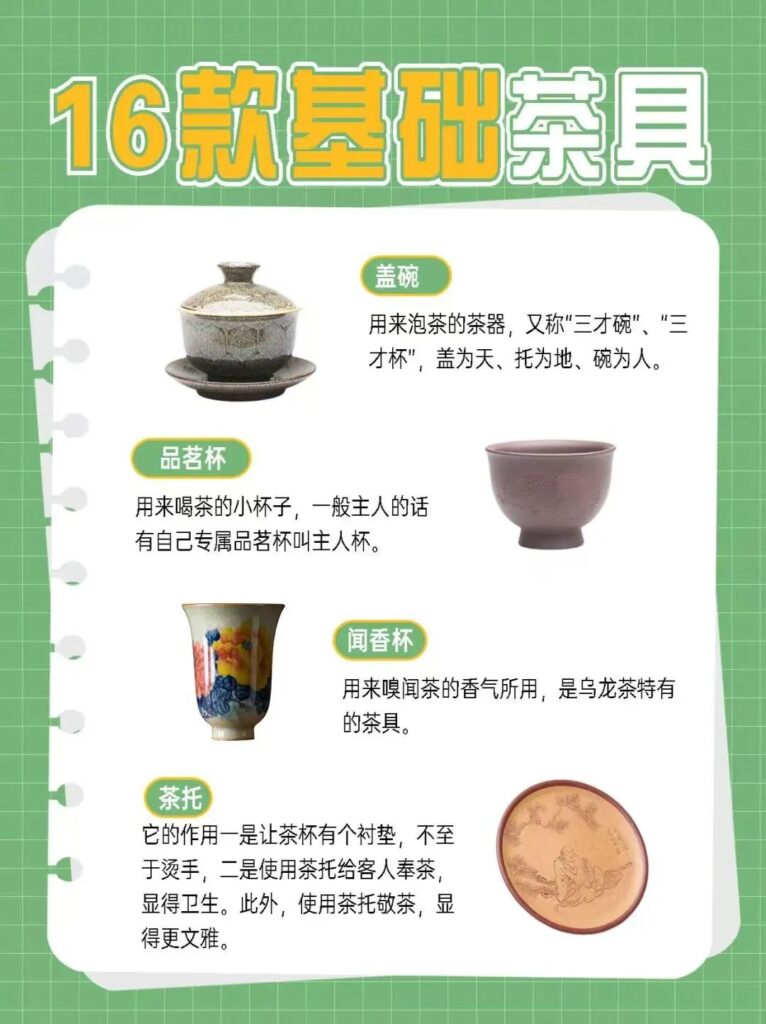When I was young, I observed that the elders would drink tea from a large teapot or a glass cup. In ancient costume dramas, one would see a bowl with a lid. Later, while working in places like Fujian and Guangdong, I encountered a variety of pots and jars being used (what are these for?). Today, I will systematically explain the tea sets used for drinking tea. Logically, isn’t tea just a matter of steeping it in water? Why are there so many different utensils? This is because people primarily drank green tea in the past, and in recent times, fermented teas such as oolong, red, and black have become popular.
These high-fermentation teas become too strong and sour if steeped for too long, leading to the need for tea and water separation. Despite the variety, the core function of all these pots and jars, apart from the tea-drinking cup, is to separate tea from water.1. Glass Cups/Any Cup: For low-fermentation teas (green, yellow, white), if you don’t want to bother with tea and water separation, you can simply use a single cup. Transparent glass cups are indeed visually appealing when steeping tea leaves. In the early years, most people would use just one cup for tea. Remember to refill the water when there’s a quarter cup left, so the tea flavor can last longer.
2. Crescent Cups: If you say, ‘I can’t do without tea and water separation for red/black/oolong teas, but I want to keep it simple,’ then focus on the core, which is tea and water separation. Use the following tool. For example, steep black tea in it for a few minutes, then pour it into your large teapot. Simple and straightforward. A principle: spend 20% of the effort to solve 80% of the core issues. If, after some time, you still find it troublesome, then just use the crescent cup, a single cup to solve it all, without the tea reaching your mouth. 3. Drifting Cups: If you say, ‘Brother, this is too rudimentary, I need to maintain face at the office,’ then consider the drifting cup below. It essentially steeps tea on top and, with a press, allows the steeped tea to flow to the bottom, from where you can pour and drink it. The biggest issue with this is that it’s not easy to clean, too much fuss, not suitable for a lazy person like me. 4. Tea and Water Separation Insulated Cup: If you say, ‘Brother, I also want to enjoy tea when I’m out, and it needs to be portable and separate tea from water,’ then use the following. This item is divided into two parts, simply add tea, invert the cup to steep, and once steeped, right the cup and drink. The downside is that the sealed glass tends to leak when inverted. I’ve tried several models, and they all leak. Maybe it’s because I haven’t spent enough money. 5. Quick-Serve Cups: From here on, it starts to look more sophisticated, but also more troublesome. The principle is that, due to the presence of a filter pot, the teapot serves as both a steeping cup and a fair cup, saving one cup.Additionally, due to their compact size, some of these sets come with a bag, allowing you to carry them around wherever you go. Enjoying tea while traveling is quite an experience. Six: Gaiwan, the oldest type of Gaiwan is here. For portability and simplicity, a Gaiwan and a tea drinking cup are sufficient; after brewing in the Gaiwan, pour the tea into the cup. For a more refined experience, add a few small tasting cups to the Gaiwan. Some Gaiwans are even designed to be portable, so search for ‘portable Gaiwan’. If someone mentions that Gaiwans are hot to handle, no problem, search for ‘heat-resistant Gaiwan’. If you say that this setup lacks a certain feel and you are pursuing a sensation, then go for a combination of Gaiwan + strainer + fairness cup + tasting cups + tea table. Seven: Teapot/Zisha Pot. This is a teapot that replaces the Gaiwan for brewing tea. The advantage is that it does not burn your hands, but the downside is that it is too heavy. There is a type called Zisha pot, which is very expensive and deep in water. It is said that it needs to be nurtured to bring out a richer flavor, which is too metaphysical and high-end for me to touch. Eight: Summary. Other miscellaneous items such as tea racks and so on are not mentioned here, as we are not into tea art. Personally, I mainly have two sets at the office: for green/white/yellow teas, I simply brew in a glass cup without separating the tea leaves and water. For oolong/red/black teas, I brew in a crescent cup and then pour into a glass cup. At home: for green/white/yellow teas, I also brew directly in a glass cup without separating the tea leaves and water. For oolong/red/black teas, if I am not in the mood, I simply brew in a crescent cup and pour into a glass cup. If I am in the mood, I use the full set of Gaiwan. Friends, you can choose based on your personal situation and the advantages and disadvantages of various tea sets.



